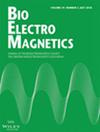Rosa Orlacchio, Yann Percherancier, Florence Poulletier De Gannes, Annabelle Hurtier, Isabelle Lagroye, Philippe Leveque, Delia Arnaud-Cormos
求助PDF
{"title":"In Vivo Functional Ultrasound (fUS) Real-Time Imaging and Dosimetry of Mice Brain Under Radiofrequency Exposure","authors":"Rosa Orlacchio, Yann Percherancier, Florence Poulletier De Gannes, Annabelle Hurtier, Isabelle Lagroye, Philippe Leveque, Delia Arnaud-Cormos","doi":"10.1002/bem.22403","DOIUrl":null,"url":null,"abstract":"<p>This study aims to analyze in real-time the potential modifications induced by low-level continuous-wave and Global System for Mobile Communications radiofrequency (RF) exposure at 1.8 GHz on brain activation in anesthetized mice. A specific in vivo experimental setup consisting of a dipole antenna for the local exposure of the brain was fully characterized. A unique neuroimaging technique based on a functional ultrasound (fUS) probe was used to observe the areas of mice brain activation simultaneously to the RF exposure with unprecedented spatial and temporal resolution (~100 μm, 1 ms) following manual whisker stimulation using a brush. Numerical and experimental dosimetry was carried out to characterize the exposure and to guarantee the validity of the biological results. Our results show that the fUS probe can be efficiently used during in vivo exposure without interference with the dipole. In addition, we conclude that exposure to brain-averaged specific absorption rate levels of 2 and 6 W/kg does not introduce significant changes in the time course of the evoked fUS response in the left barrel field cortex. The proposed technique represents a valuable instrument for providing new insights into the possible effects induced on brain activation under RF exposure. For the first time, brain activity under mobile phone exposure was evaluated in vivo with fUS imaging, paving the way for more realistic exposure configurations, i.e. awake mice and new signals such as the 5 G networks. © 2022 Bioelectromagnetics Society.</p>","PeriodicalId":8956,"journal":{"name":"Bioelectromagnetics","volume":"43 4","pages":"257-267"},"PeriodicalIF":1.8000,"publicationDate":"2022-04-29","publicationTypes":"Journal Article","fieldsOfStudy":null,"isOpenAccess":false,"openAccessPdf":"","citationCount":"0","resultStr":null,"platform":"Semanticscholar","paperid":null,"PeriodicalName":"Bioelectromagnetics","FirstCategoryId":"99","ListUrlMain":"https://onlinelibrary.wiley.com/doi/10.1002/bem.22403","RegionNum":3,"RegionCategory":"生物学","ArticlePicture":[],"TitleCN":null,"AbstractTextCN":null,"PMCID":null,"EPubDate":"","PubModel":"","JCR":"Q3","JCRName":"BIOLOGY","Score":null,"Total":0}
引用次数: 0
引用
批量引用
Abstract
This study aims to analyze in real-time the potential modifications induced by low-level continuous-wave and Global System for Mobile Communications radiofrequency (RF) exposure at 1.8 GHz on brain activation in anesthetized mice. A specific in vivo experimental setup consisting of a dipole antenna for the local exposure of the brain was fully characterized. A unique neuroimaging technique based on a functional ultrasound (fUS) probe was used to observe the areas of mice brain activation simultaneously to the RF exposure with unprecedented spatial and temporal resolution (~100 μm, 1 ms) following manual whisker stimulation using a brush. Numerical and experimental dosimetry was carried out to characterize the exposure and to guarantee the validity of the biological results. Our results show that the fUS probe can be efficiently used during in vivo exposure without interference with the dipole. In addition, we conclude that exposure to brain-averaged specific absorption rate levels of 2 and 6 W/kg does not introduce significant changes in the time course of the evoked fUS response in the left barrel field cortex. The proposed technique represents a valuable instrument for providing new insights into the possible effects induced on brain activation under RF exposure. For the first time, brain activity under mobile phone exposure was evaluated in vivo with fUS imaging, paving the way for more realistic exposure configurations, i.e. awake mice and new signals such as the 5 G networks. © 2022 Bioelectromagnetics Society.
射频照射下小鼠脑内功能超声(fUS)实时成像及剂量测定
本研究旨在实时分析1.8 GHz低水平连续波和全球移动通信系统射频(RF)暴露对麻醉小鼠脑激活的潜在影响。一个特定的体内实验装置组成的偶极天线局部暴露的大脑充分表征。采用一种独特的基于功能性超声(fUS)探针的神经成像技术,以前所未有的空间和时间分辨率(~100 μm, 1 ms)观察了用刷子手动刺激须后射频暴露同时激活的小鼠大脑区域。采用数值和实验剂量学对辐照进行了表征,并保证了生物学结果的有效性。我们的研究结果表明,fUS探针可以有效地在体内暴露时使用,而不会干扰偶极子。此外,我们得出的结论是,暴露于2和6 W/kg的脑平均比吸收率水平下,不会导致左侧桶状野皮层诱发的fUS反应的时间过程发生显著变化。所提出的技术代表了一种有价值的工具,为射频暴露下对大脑激活可能产生的影响提供了新的见解。这是第一次使用fUS成像技术评估手机暴露下的大脑活动,为更真实的暴露配置铺平了道路,即清醒的小鼠和5g网络等新信号。©2022生物电磁学学会。
本文章由计算机程序翻译,如有差异,请以英文原文为准。

 求助内容:
求助内容: 应助结果提醒方式:
应助结果提醒方式:


